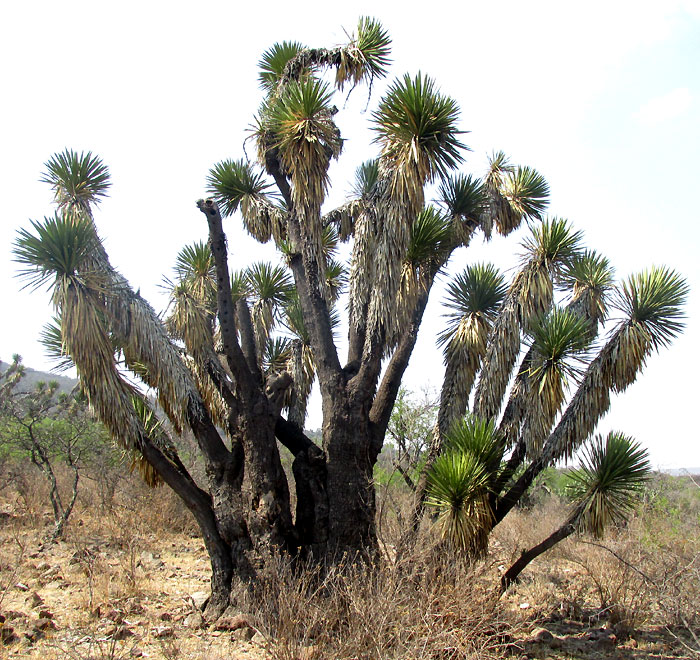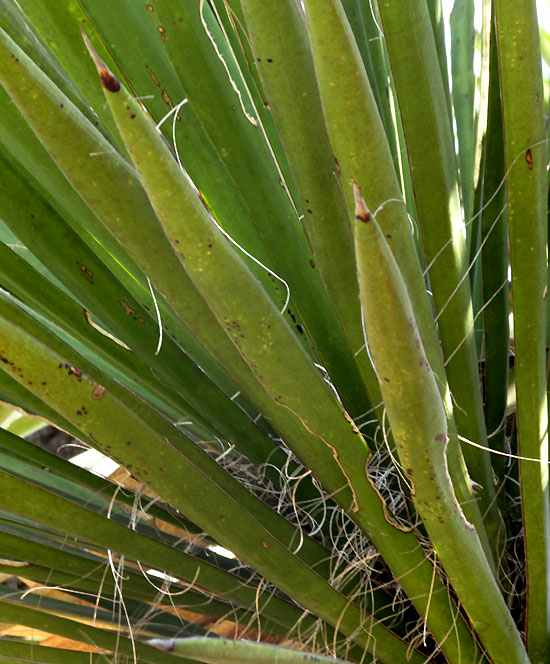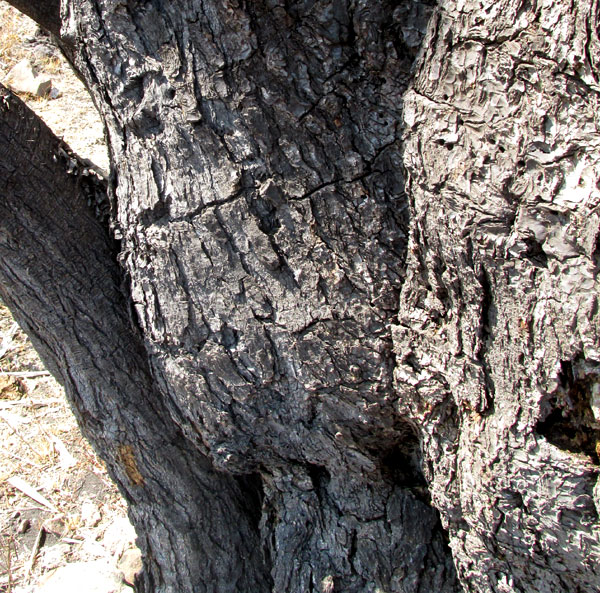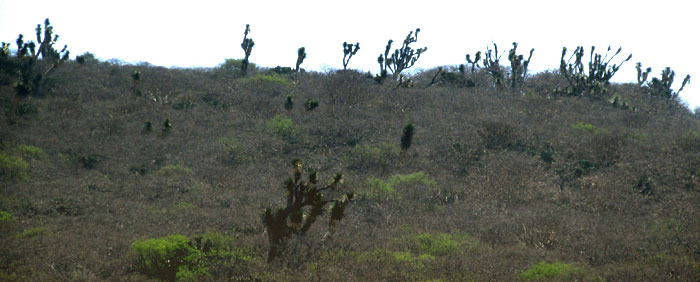Excerpts from Jim Conrad's
Naturalist Newsletter
entry dated April 6, 2023, with notes from the lower slope of hill south of El Cerrito, 5kms south of Tequisquiapan; bedrock volcanic andesite, an intermediate rock between basalt and rhyolite; elevation about 2,000m (6600 ft), Querétaro state, MÉXICO
(~N20.47°, ~W99.89°)
YUCCA FILIFERA

Rising well above the surrounding dry-season parched and overgrazed landscape, the above yucca was a dominant and majestic presence. Earlier I've seen that identifying yuccas to species level can be tricky, so field marks to notice here are, first, that the species is uncommonly tall with much branching stems, and that the trunk is broad at the base with fairly slender branches.

Our yucca bore neither flowers nor fruits, but at the tips of a few stems, as shown above, old inflorescence parts remained, their tips pointed downward.

An important field mark is seen above: From the leaves' margins arise white, stiff, curly filaments.

Yuccas are monocots, like grasses, lilies and orchids, but this yucca's trunk bore bark that would look right covering certain oak species, which are dicots. Our yucca species was particularly common along the ridge above, and from a distance presented a strange and wonderful impression:

At this writing the GBIF Yucca page recognizes 122 Yucca species, though the Flora of North America estimates 35-40, all native to the Americas. The Flora also indicates that the delimitation of the genus Yucca is still unresolved. No overall study of the Mexican yuccas is available.
However, for Querétaro state I find only two Yucca species documented. One of them is the narrowly endemic Yucca queretaroensis, which grows to only 4m tall (13ft), lacks numerous slender branches, and its trunk remains thickly covered with a shag of old, dead leaves. The other species reaches 10m (33ft), can sprout up to 40 branches, and its shag of dead leaves is much slenderer and gives way to bark-covered stem. The taller species is YUCCA FILIFERA, the species name filifera referring to the white filaments curling off the leaves' margins. You might be interested in comparing this species with the similar Yucca carnerosana we saw in northern Mexico.
Yucca filifera is endemic just to upland northern and central Mexico. Laura Rentería and César Cantú in their 2003 study "El Efecto de Tegeticula yuccasella Riley (Lepidoptera: Prodoxidae) sobre la Fenología Reproductiva de Yucca filifera Chabaud (Agavaceae) en Linares, N.L., México" tells us that yucca species are exclusively pollinated by female moths of the Yucca Moth Subfamily, the Prodoxinae. The relationship of a yucca species and its moth is one of "obligate mutualism" -- each species absolutely requiring the other to survive.
In our Yucca filifera it's been shown that if the small, white yucca-moth species Tegeticula yuccasella does a good job pollinating numerous flowers, more of its offspring will survive. That because yucca flowers going unpollinated, or receiving pollen from the same plant, simply fall off without producing fruits. When yucca moths pollinate yucca flowers, they lay eggs in the flowers, and the eggs produce larvae which feed on the fruit's developing seeds. Clearly, too many moths means a plunge in yucca numbers; too few yuccas mean fewer moths. Exterminate one species, and the other disappears. I wonder if Yucca filifera is absent in the valley below this slope because of the prodigeous use of insecticides in the many fields and green houses there?
In many warmer places Yucca filifera is grown in gardens, and marketed in English by many names, none of them frequently used. It's the same case in Spanish, though izote frequently is heard, that name being applied to a number of yucca species. Not only is the species a gardening favorite, but it's adaptable enough to flourish indoors in large pots.
Yucca filifera is one of numerous yucca species whose flowers and fruits can be eaten raw or cooked. The flowering stem can be cooked and used like asparagus, which resonates with the fact that yuccas belong to the Asparagus Family, the Asparagaceae.
Indigenous Mexicans took advantage of the fact that the roots of Yucca filifera and other yucca species are rich in saponins, meaning both that the roots could be pounded in water to produce a soap, and the saponins can be used medicinally. In the online Biblioteca Digital de la Medicina Tradicional Mexicana it's stated that the Otomí of our area have made water solutions of Yucca filifera stem-hearts along with other ingredients to cure toothaches. Other ingredients listed are sliced lemon, a piece of Aloe Vera leaf, the heart of the cactus Pachycereus pringlei, and soot from the fireplace. Other sources mention yuccas being used for ailments ranging from hypertension, high cholesterol, swelling and stiffness, to liver and gallbladder disorders, migraines and osteoarthritis.